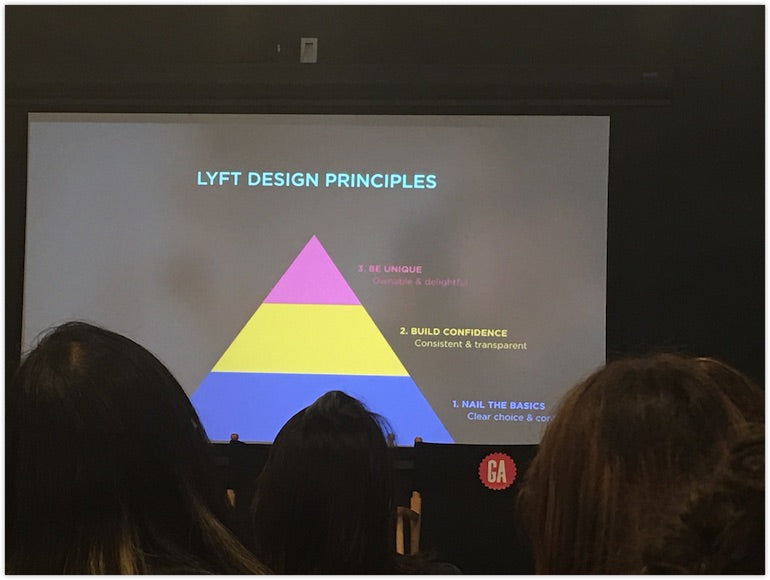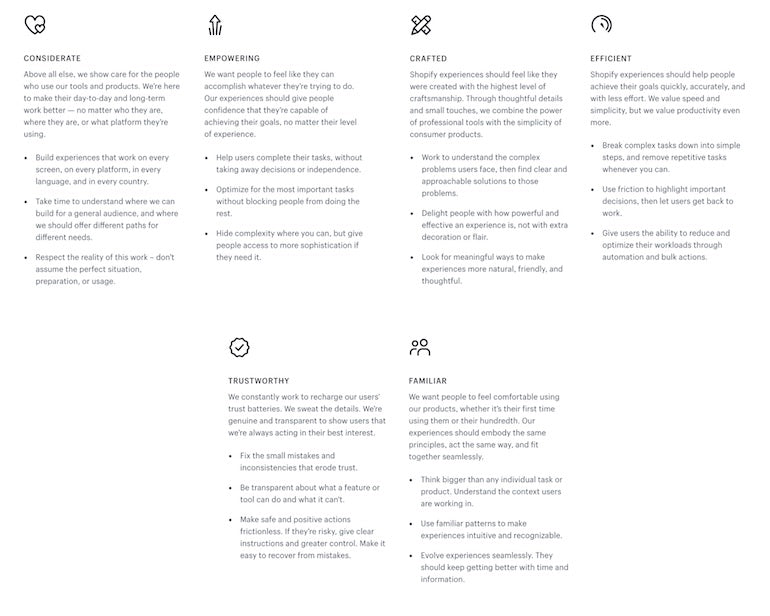
When several people are on a team, they are bound to run in to the issue of having competing opinions of what makes a good design or not and what solid design principles are.
Or, will they?
This is where standardized design principles come in to play. Design principles are what unite a team and guide them towards the ultimate goal—creating a great user experience for people who will use the product that they’re creating.
In this article, you’ll learn about a nine-step process for creating a solid set of guidelines for not only designers, but for all other team members as well.
What are design principles?
Design principles act as standards for the product team and help them measure the quality of their work. They replace subjective ideals with clear standards that help team members make user-centered design decisions.
Without a common understanding of what makes design great at an organization, everyone is left to act according to their gut feelings. This makes the outcome of the design process entirely unpredictable, and can cause issues in the quality of the work output.
A simple solution exists for this problem, called design principles. Solid principles capture the essence of what good design means for the company. They provide practical recommendations for product teams on how to achieve amazing results.
Here are some benefits that design principles bring to the product design process. They:
- Enhance usability. Good principles make it easier to work on user-centered design.
- Force clarity. Design principles improve the decision-making process. Solid principles reduce arguments that team members may have when they implement a product.
- Educate the team. Design principles are a reflection of the culture of an organization. Whenever a new person joins a team, they can understand the values of the organization.
You can read our guide to getting started with user experience design if you’d like some more background information.
9 tips for establishing solid design principles
Here are some fundamental rules that a team needs to follow to make design principles usable:
1. Establish ownership
Establishing design principles is a project, and similar to any other project, you need a project manager to manage the interaction of the work and team members.
It’s tempting to skip assigning an owner and say, “the design team will deal with it.” But in most cases, when nobody explicitly owns the project, it’ll never get done.
You might also like: 7 Essential Digital Project Management Best Practices.
That’s why it’s better to select a person or a group of people who are responsible for the activity.
2. Be inspired
Before defining your own design principles, you should start by researching the design principles of other companies.
Check Design Principles FTW and Principles.design. These resources contain a collection of design principles from Airbnb, Intercom, IBM, and more.
You should then note down the principles that you’re interested in adopting for your own projects.
3. Remember the core requirements
Here are a few fundamental things to remember when working on your design principles:
- Design principles should be actionable. They should offer practical guidance on how to solve a design problem within the context of a particular product.
- Design principles should be authentic and genuine. Often, you’ll see design principles that say something like, “intuitive design.” Qualities like this should be part of your product strategy, but not your design principles. Knowing that your product should be intuitive is not helpful in guiding your design decisions. Imagine that a new member joins your team and reads, “We want to create clean and intuitive design.” That doesn’t really tell the person much. It’s hard to imagine that anyone would intentionally create a complex product with bad usability. So, if you want to mention intuitive design, it's better to say something like, “make users feel in control of their experience.”
- Design principles should be memorable, but leave room for the design process to happen. When you ask the people in your company what your design principles are, they should be able to say them off the top of their heads. As well, product creators should not feel limited or restrained by the principles. It’s important that everyone feels comfortable while doing their work, not restrained by inflexible or suffocating standards.
4. Invite all team members to participate in the process of creation
In many cases, it’s not hard to make people follow the rules. Rather, it’s hard to make people agree on the rules. That’s why it’s essential not only to establish grounding principles of design, but also to get a commitment to those principles from the people involved in the creation of the product.
People have more motivation to use design principles in their work when they know that they took part in the process of creating those principles.
"People have more motivation to use design principles in their work when they know that they took part in the process of creating those principles."
It’s important to include different people from across the company in the process of creating these guidelines. Invite everyone from designers, developers, project managers, copywriters, to usability specialists in discussion sessions, with the goal being to draft a list of design principles.
Ask them to write their ideas of what they think good design is on cards or sticky notes. Ensure that they provide a rationale behind every idea. Combine similar concepts and allow team members to evaluate the combinations during the brainstorming process.
Follow this simple process to narrow down the top principles:
- Ask everyone to write down their principles on sticky notes
- Put sticky notes up on the wall to group them
- Rank their importance.
- Allow each team member to talk about their principles (let them explain their ideas)
- Ask team members to vote on the best ideas
5. Prioritize the principles
Once you have a list of principles that you think is reasonable, you need to prioritize them and select the top five strongest, most distinct principles. You can use Maslow’s hierarchy of needs for this, which was an approach that was first popularized by the Lyft design team.

In her article Determining Your Design Principles, Jessie Chen describes how to put design principles into the pyramid based on the way a team wants to rank them. See Jessie’s example below:

You can’t have 100 principles—nobody will ever be able to remember them and may get confused in the process.
That’s why you need to follow this process, focus on a core set that will guide your vision, and use them to propel your team forward.
6. Ensure that the design principles match the nature of your organization
Design principles align people around what matters.
That’s why it’s essential to evaluate every design principle according to the vision of the organization.
It’s important to note that you will need to evaluate the principles with stakeholders, because you don’t want to end up with a list that brings value only for a design team. For example, here are Shopify’s experience values:

Evaluate every principle using the following set of questions:
- Is the principle true to our organization/product/team?
- Will this principle work for our brand?
- Can this principle inspire great design decisions tomorrow?
By using these questions and prior samples, you’ll come up with your own great list.
7. Provide examples
Even the best principles can be interpreted in different ways. Nothing makes a principle clearer than being paired with a real-life example, showing how it can be applied in practice.
You might also like: 22 Basic UX Laws That Every Designer Should Know
Try to follow the ‘show, don’t tell’ approach, and pair the written explanation of the principle with a relevant example.
An example might be a text copy or an illustration of a user interface. In other words, anything that will help the reader match the concept with a practical application. By doing this, you will increase the chances that all team members understand the core idea behind every principle.
Tip: Sometimes you also need to provide counterexamples to help people understand what not to do.
8. Make the principles easily visible
Make the principles easily visible throughout your organization. In many cases, these places are internal wikis, or posters displayed in public areas.
Reference the principles in a meeting when you’re discussing design. For example, when someone from your team asks about the rationale behind a certain design decision, you can reference a principle that explains it.
The more the principles are displayed and actively used in the day to day work, the more people will understand and use them in their own decisions.
"The more the principles are displayed and actively used in the day to day work, the more people will understand and use them in their own decisions."
9. Stick to the principles
It’s easy to come up with design principles, but it’s hard to stick to them.
It’s worth scheduling regular meetings to review the principles with makers, users, and stakeholders. By doing this, you’ll know whether teams are actually following the principles in their processes.
You might also like: Redesigning the Design Process: How to Work More Efficiently This Year.
It’s especially important to follow this procedure when you’re just starting to introduce design principles into your organization. Discuss what works and what does not, what needs to be improved, and when.
These meetings will help you set priorities and create a roadmap to enhance the principles, so that they can continuously serve the needs of your users and the business.
Follow this guide to establish clear design principles
Strong principles are an integral part of any organization that designs products. The earlier a team establishes a clear set of design principles, the more time it will save along the way. Clean, concise, and actionable principles are excellent guideposts because they force clarity and help everyone to create better products.
Read more
What design principles have you established with your team? Let us know in the comments below.




